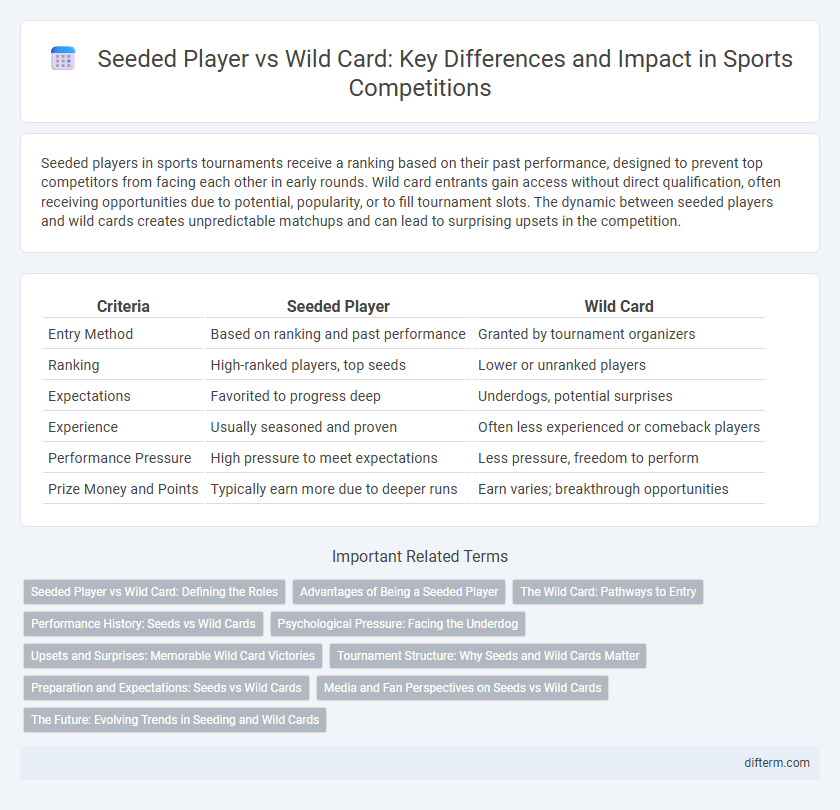Seeded players in sports tournaments receive a ranking based on their past performance, designed to prevent top competitors from facing each other in early rounds. Wild card entrants gain access without direct qualification, often receiving opportunities due to potential, popularity, or to fill tournament slots. The dynamic between seeded players and wild cards creates unpredictable matchups and can lead to surprising upsets in the competition.
Table of Comparison
| Criteria | Seeded Player | Wild Card |
|---|---|---|
| Entry Method | Based on ranking and past performance | Granted by tournament organizers |
| Ranking | High-ranked players, top seeds | Lower or unranked players |
| Expectations | Favorited to progress deep | Underdogs, potential surprises |
| Experience | Usually seasoned and proven | Often less experienced or comeback players |
| Performance Pressure | High pressure to meet expectations | Less pressure, freedom to perform |
| Prize Money and Points | Typically earn more due to deeper runs | Earn varies; breakthrough opportunities |
Seeded Player vs Wild Card: Defining the Roles
Seeded players in sports tournaments are ranked competitors who receive a favorable position in the draw based on their world rankings and past performances. Wild card entrants gain entry without meeting standard qualification criteria, often granted to promising local talent or returning champions to boost tournament appeal. Understanding these distinct roles highlights the balance between structured competition and opportunities for emerging athletes.
Advantages of Being a Seeded Player
Seeded players benefit from higher rankings that grant them favorable draws in tournaments, often avoiding early matches against other top competitors. This advantageous positioning increases their chances of progressing to later rounds and earning valuable ranking points and prize money. Wild card entrants face tougher initial matchups due to lower rankings and less consistent tournament experience.
The Wild Card: Pathways to Entry
The wild card offers a unique pathway to entry in sports tournaments, allowing players who may not meet direct qualification criteria to compete based on potential, past performance, or local interest. Unlike seeded players, who earn their positions through rankings and consistent results, wild cards often bring unpredictable dynamics and fresh competition to the event. This mechanism enhances diversity in the sport, providing opportunities for emerging talents and fan favorites to showcase their skills on a prominent stage.
Performance History: Seeds vs Wild Cards
Seeded players consistently demonstrate stronger performance history, reflecting higher ATP or WTA rankings and consistent tournament success, which translates to favorable match outcomes. Wild card entrants often show more variability in results, as their inclusion is based on potential or past achievements rather than current form, leading to less predictable performance against top-seeded opponents. Analysis of grand slam and ATP/WTA event data reveals seeded players win approximately 75% of encounters against wild cards, underscoring the impact of ranking and experience on match results.
Psychological Pressure: Facing the Underdog
Seeded players often experience heightened psychological pressure when facing wild card entrants due to the expectation to win and maintain ranking points. This underdog dynamic can cause stress, leading to unforced errors and reduced confidence during critical moments. Wild card players capitalize on this mental edge, often performing more freely and aggressively against their favored opponents.
Upsets and Surprises: Memorable Wild Card Victories
Wild card entrants have historically delivered some of the most thrilling upsets in sports, toppling high-seeded players against all odds. Notable examples include Goran Ivanisevic's 2001 Wimbledon triumph and Kim Clijsters' 2009 US Open win as a wild card, both defying expectations with remarkable performances. These surprising victories highlight the unpredictability of tournaments and the potential for underdogs to challenge the status quo.
Tournament Structure: Why Seeds and Wild Cards Matter
Seeded players receive preferential placement in tournament brackets based on rankings, ensuring that top athletes avoid early matchups and maintain competitive balance throughout the event. Wild cards are granted to players who did not meet qualification criteria but bring potential excitement or local interest, enriching the tournament's diversity and fan engagement. This structured blend of seeds and wild cards preserves fairness while enhancing the tournament's appeal and unpredictability.
Preparation and Expectations: Seeds vs Wild Cards
Seeded players undergo rigorous preparation, leveraging extensive match experience and strategic planning to meet high expectations in tournaments. Wild card entrants often face unpredictable challenges, relying on raw talent and adaptability while balancing limited preparation time. The contrast in readiness and pressure distinctly shapes performance outcomes in competitive sports events.
Media and Fan Perspectives on Seeds vs Wild Cards
Media coverage often highlights seeded players as favorites due to their consistent rankings, while wild card entrants attract attention for their unpredictability and potential to cause upsets. Fans tend to appreciate the excitement wild cards bring, rooting for underdogs and surprise narratives that challenge established hierarchies. The contrasting perceptions generate dynamic storytelling that enriches the sports viewing experience and fuels engagement across social platforms.
The Future: Evolving Trends in Seeding and Wild Cards
Emerging trends in tennis show an increasing emphasis on data analytics and player performance metrics to refine seedings, enhancing fairness and competitiveness in tournaments. Wild card entries are evolving beyond traditional nationality or promotional criteria, with more opportunities granted to young, high-potential athletes identified through advanced scouting technologies. This shift promotes a dynamic tournament landscape, balancing established elite players with rising talent, ultimately shaping the future of competitive sports.
seeded player vs wild card Infographic

 difterm.com
difterm.com